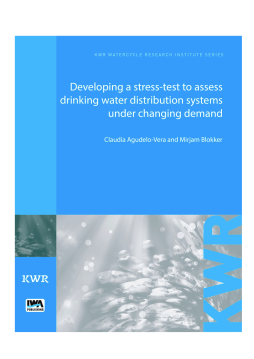
BOOK
Developing a Stress-Test to Assess Drinking Water Distribution Systems Under Changing Demand
Claudia Agudelo-Vera | Mirjam Blokker
(2016)
Additional Information
Book Details
Abstract
The drinking water distribution system (DWDS) is a critical infrastructure and a costly asset with a life time of several decades. With rapidly changing urban environments and increasing technological innovation, drinking water demand is likely to change in the coming decades. However, quantifying these changes involves large uncertainties. This book develops a methodology to analyse the robustness of the DWDS to deal with a wide range of future water demands.
A stress test was developed to investigate the effects of a set of demand scenarios on the network performance. In a first stage ten scenarios considering technological and demographic changes were applied and in a second stage, a more in depth analysis comparing the performance of a looped versus a branched design was performed, simulating 30 patterns per connection.
The proposed “stress-test” showed to be a robust methodology to investigate functionality of the system under a broad range of changing water demand scenarios. Results showed that even in the most extreme scenarios management and operation of the network can be adapted or adjusted to cope with head losses, low velocities or long residence times.
Table of Contents
| Section Title | Page | Action | Price |
|---|---|---|---|
| Cover | Cover | ||
| Contents | 6 | ||
| 1 Introduction | 7 | ||
| 1.1 Problem description | 7 | ||
| 1.2 Research steps | 7 | ||
| 1.3 Approach | 8 | ||
| 1.4 Outcomes | 9 | ||
| 2 Stress-test to determine network robustness | 10 | ||
| 2.1 Introduction | 10 | ||
| 2.2 Scenarios description | 10 | ||
| 2.3 Networks description | 12 | ||
| 2.4 Simulating drinking water demand | 13 | ||
| 2.5 Results overview | 13 | ||
| 2.5.1 Daily water demand and peak demand | 13 | ||
| 2.5.2 Maximum head loss | 16 | ||
| 2.5.3 Maximum residence time | 16 | ||
| 2.5.4 Overview of the results | 17 | ||
| 3 Stress-test to determine network robustness – Two networks layouts and 30 scenarios | 18 | ||
| 3.1 Networks description | 18 | ||
| 3.2 Daily water consumption and peak demand | 19 | ||
| 3.3 Head loss | 21 | ||
| 3.4 Water quality: residence time and self-cleaning capacity | 22 | ||
| 3.5 Customers minutes lost | 24 | ||
| 3.6 Network performance, robustness and operability | 24 | ||
| 4 Transitions in the drinking water demand | 27 | ||
| 5 Conclusions and recommendations | 29 | ||
| 6 References | 31 |
